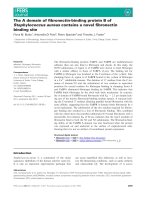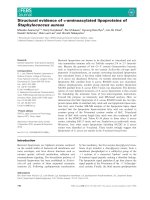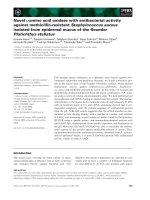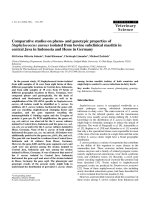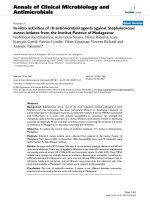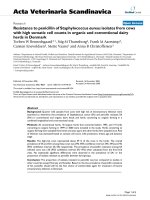Isolation and antibiotics susceptibility profile of staphylococcus aureus isolated from poultry meat and associated environment in and around Junagadh district, Gujarat, India
Bạn đang xem bản rút gọn của tài liệu. Xem và tải ngay bản đầy đủ của tài liệu tại đây (178.47 KB, 8 trang )
Int.J.Curr.Microbiol.App.Sci (2019) 8(10): 800-807
International Journal of Current Microbiology and Applied Sciences
ISSN: 2319-7706 Volume 8 Number 10 (2019)
Journal homepage:
Original Research Article
/>
Isolation and Antibiotics Susceptibility Profile of Staphylococcus aureus
Isolated from Poultry Meat and Associated Environment in and around
Junagadh District, Gujarat, India
K. R. Bhedi1*, S. H. Sindhi1, J. B. Kathiriya1, B. S. Mathapati2 and A. R. Bariya3
1
Department of Veterinary Public Health and Epidemiology, 2Department of Veterinary
Microbiology, 3Department of Livestock Products Technology, College of Veterinary Science
and Animal Husbandry, Junagadh Agricultural University,
Junagadh-362001, Gujarat, India
*Corresponding author
ABSTRACT
Keywords
S. aureus, Poultry
meat, Antimicrobial
susceptibility
Article Info
Accepted:
07 September 2019
Available Online:
10 October 2019
The present study was undertaken to investigate the ecological studies of S.
aureus isolates from poultry meat and associated environment in and around
Junagadh District. A total of 200 Poultry meat and associated environment
samples which comprised of Tracheal swabs (n=40), Cloacal swabs (n=40),
Skin swabs (n=40), Meat (n=40) and environment sample (knife samples
(n=20) and butcher’s hand swabs (n=20) were collected from different retail
poultry meat shops located in and around Junagadh district. Out of 200
samples, 27 isolates of S. aureus were found positive for S. aureus by culture
and these isolates were further confirmed by biochemical test. The obtained S.
aureus isolates were subjected to antibiotic sensitivity test. The isolates were
found highly resistant to the Ampicillin (70.37%) followed by Tetracycline
(62.96%) Co-Trimoxazole (33.33%), Methicillin (25.92%), Chloramphenicol
(22.22%) and Vancomycin (18.51%) in their decreasing order. This study
confirmed the presence of S. aureus, especially antibiotic-resistant strains in
poultry meat.
Introduction
Throughout the Worldwide, millions of people
were suffering from communicable and non –
communicable
diseases
caused
by
contaminated food. These diseases cause
heavy toll in human life and suffering,
particularly among infants, children, elderly
and other susceptible persons. (van der vanter,
1999). Nowadays foods borne disease are of
800
Int.J.Curr.Microbiol.App.Sci (2019) 8(10): 800-807
global public health concern and they are
causing wide variety of illness and sometime
even cause mortality in human beings. The
survival of spores through the cooking
process, germination, proliferation and
production of toxins in food are responsible
for human food borne diseases and source of
the causative microorganisms (Senait and
Moorty, 2016).
Food borne diseases are one of the major
causes of concern in developing countries
resulting in several deaths annually along with
billions of dollars of economic burden.
According to World Health Organization
(WHO), approximately 600 million people are
getting infected and around 420,000 die
annually worldwide due to food borne
pathogens. Most cases of food born outbreak
are caused by Salmonella, Campylobacter,
Escherichia coli, Listeria, Vibrio cholera and
Staphylococcus aureus had been reported
worldwide (Who, 2015; Herve and Kumar,
2017).
From last few decades poultry is a major
fastest growing source of meat in world.
(Kearney, 2010; Islam et al., 2014) Now there
is upward trend in production and
consumption of poultry meat and consumer
expect safe and hygienic product without
contamination
with
pathogenic
microorganisms (Islam et al., 2014).
al., 2016). It is a Gram-positive bacterium that
can be commonly found on the skin or in the
nasal passages of most humans and animals
(Jackson et al., 2013). It’s widespread in the
environment and often detected in air, dust,
water, raw meat, other foods, and on
environmental surfaces. It also produces heatstable enterotoxins during growth on a variety
of foods, including meat and poultry products,
eggs, cream-filled pastries, potatoes, and some
salads. It survives desiccation and tolerates
high levels of salt too. So it has become food
safety concern for meat producers and food
processors (Cunha et al., 2006; Owuna et al.,
2015).
The presence of S. aureus in meat is often
attributed to inadequate hygiene during
handling by the individuals involved in the
production of meat (Moustafa et al., 2016).
The presence of S. aureus in poultry meat
posses a potential health hazard to consumers
and the identification of such strains should be
used as a part of risk analysis of meat and
poultry products (Owuna et al., 2015).
Therefore, the present study aims to isolate,
characterize
and
determine
antibiotic
sensitivity pattern Staphylococcus aureus from
poultry meat and associated environment in
and around Junagadh district area.
Materials and Methods
Poultry also act as important source and
vehicle for transmission of food borne
pathogen. At the time of slaughtering of
poultry birds, there may be cross
contamination of carcass with fecal and gut
contain which may passed on as contaminants
(Moustafa et al.,2016).
Staphylococcus aureus is one of the most
important pathogenic bacteria due to its ability
to cause food-borne diseases and various types
of infections in human and animals (Świda et
Study area and Source of Material
A total of 200 Poultry meat and associated
environment samples which comprise of
Tracheal swabs (n=40), Cloacal swabs (n=40),
Skin swabs (n=40), Meat (n=40) and
environment sample (knife samples (n=20)
and butcher’s hand swabs (n=20) were
collected from different retail poultry meat
shops located in and around Junagadh district,
under aseptic precautions.
801
Int.J.Curr.Microbiol.App.Sci (2019) 8(10): 800-807
Isolation
and
identification
Staphylococcus aureus
of
Enrichment of samples was carried out in
Peptone Water (PW) enrichment broth. 25 gm
poultry meat and swab samples were
homogenized with 90 ml sterile enrichment
broth peptone water and enriched for 24 hrs at
37 °C. A loopful of inoculum from enrichment
broth were streaked on Baird-Parker agar
(BPA) medium supplemented with egg-yolk
tellurite emulsion and incubated for 48 h at 37
°C. Characteristic appearance of jet black
colonies surrounded by a white halo zone on
BPA (Fig. 1) and golden yellow colour on
Nutrient Agar (Fig. 2) was considered as
positive.
Biochemical Characterization
Suspected colony on BPA and Nutrient Agar
was further characterized by gram’s stain
other biochemical tests like Catalase test,
Oxidase test, Voges Proskauer test, Coagulase
production,
Deoxyribonuclease
(DNase)
activity.
Determination of antibiotic susceptibility
test (ABST) by Disc Diffusion method
All the S. aureus isolates were tested for
antibiotic susceptibility by the Kirby- Bauer
disc diffusion method on Mueller Hinton agar
using commercially used antibiotic discs.
Results and Discussion
The surveillance of food for microbial
contamination is important for protection of
public health and consumer interest. Now in
this competitive global market era the
production of safe food is mandatory. With
this regard the general hygiene of poultry meat
and their associate environment including
personal hygiene of workers is also important.
Out of Two hundred (200) samples of poultry
meat and associated environment samples
obtained from in and around Junagadh district,
27 (13.5%) isolate of S. aureus were isolated
from the samples. The organisms that were
isolated in the present study were important
food borne pathogens in humans, and cause
diseases in domestic animals.
In present study overall prevalence of S.
aureus was found to be 13.5%. According to
sample wise study, the highest prevalence of
S. aureus was detected from skin swabs
(15.0%) followed by meat samples (12.0 %),
cloacal swabs (10.0%) and tracheal swabs
(7.50%). From poultry meat associated
environment samples, Butchers’ hand swab
show (25.0%) and Knife swab (20.0%)
prevalence (Table 1).
In present study, over all prevalence of S.
aureus 27 (13.5%) detected which was
correlate with findings of Hannig et al., (2012)
who reported 11.2 % (25/222) of S. aureus
isolates from whole poultry carcass in
Northwest Arkansas. The present findings
were lower than 18.18%, 24.50%, 22.00%,
30.10 % reported by Akbar and Anal (2013),
Onaolapo et al., (2017), Gwida and El-Gohary
(2015) and Fan et al., (2015) respectively.
However, the present finding is higher than
the finding of Osman et al., (2015) and EIJakee et al., (2008) who observed 6.00 %,
8.00 % prevalence respectively. The variation
in the prevalence of S. aureus may be due to
number of samples screen, sampling
procedure, quality of water used for
processing, improper sanitization of working
surface as well as hygienic outlet in different
shop in different country or any region.
The prevalence of S. aureus form Butchers’
hand swabs 25.00% was in contrast with the
finding of Gwida and El-Gohary (2015) who
reported 40.0% of S. aureus colonize the skin
802
Int.J.Curr.Microbiol.App.Sci (2019) 8(10): 800-807
of the chicken handlers. Similarly, Fan et al.,
(2015) also investigated the prevalence of S.
aureus from human, meat and poultry origin
in Henan Province in China. They reported
that 54.8% (34/62) human samples (nasal
swabs, blood and fester) were positive for S.
aureus which was in contrast to the present
study finding. However, Contrary to the
findings of our study, higher prevalence have
been reported by Omololu and Bamidele,
(2017) in Nigeria (62.5 %), Herve and Kumar,
(2017) in Punjab (46.41%), Moustafa et al.,
(2016) in Egypt (41.8 %). The variation in the
present study is may be due to increase in the
samples size of poultry meat sample and
improper handling of poultry meat by their
worker or poor personal hygiene prevalent in
the retail shop.
Antibiotic Sensitivity
In the present study, S. aureus isolates were
found variably resistant to the antibiotics
tested. Most of the S. aureus isolates were
showing high resistant activity towards
Ampicillin (70.37%) followed by Tetracycline
(62.96%),
Co-Trimoxazole
(33.33%),
Methicillin
(25.92%),
Chloramphenicol
(22.22%) and Vancomycin (18.51%) (Table 2
and Chart 1).
Table.1 Isolation of Staphylococcus aureus from poultry and associated environment
Type of Sample
Tracheal swab
Skin swab
Cloacal swab
Meat
Knife swab
Environment
Butchers’hand
swab
Total
No of samples
examined
Percentage of
S. aureus (%)
40
40
40
40
20
20
Number of
samples
positive for
S. aureus
03
06
04
05
04
05
200
27
13.5
7.5
15.00
10.0
12.5
20.00
25.00
Table.2 Antibiotic susceptibility of Staphylococcus aureus (N: 27) isolates
to Antimicrobial agents
Sr.
No.
1.
2.
3.
4.
5.
6.
Name of the antibiotic
Sensitive
Intermediate
Resistant
Ampicillin
Chloramphenicol
Co-Trimoxazole
Methicillin
Tetracycline
Vancomycin
8 (29.62%)
21(77.77%)
18(66.66%)
20(74.07%)
10(37.03%)
22(81.48%)
-
19(70.37%)
6(22.22%)
9(33.33%)
7(25.92%)
17(62.96%)
5(18.51%)
803
Int.J.Curr.Microbiol.App.Sci (2019) 8(10): 800-807
Chart.1 Antibiotic susceptibility of Staphylococcus aureus (N: 27) isolates to antimicrobial
agents
Fig.1 S. aureus on Baired parker agar having grey black colony
804
Int.J.Curr.Microbiol.App.Sci (2019) 8(10): 800-807
Fig.2 S. aureus on nutrient agar having golden color colony
The high resistance of S. aureus isolates from
fresh poultry meat to Ampicillin, Tetracycline
and Co-Trimoxazole observed in this study
was expected and however this report was not
different from other studies reported by
Similar patterns of antimicrobial susceptibility
have been reported by Fan et al., (2015). The
findings of Co-trimoxazole and Tetracycline
in our study were somewhat similar with
Onaolapo et al., (2017).
This might be due to extensive usage of these
antimicrobial agents in animal husbandry over
time period of time, which has contributed to
the selection of drug resistant strains. In
contrast to our study higher resistant to
Ampicillin, Tetracycline and Vancomycin
were reported by Abdalrahman et al., (2015).
In present study the S. aureus strains were
found highly resistant to ampicillin and
tetracycline. It may be due to this drug are
most commonly used in poultry. While
comparing with other studies, differences in
the antibiotic resistance may arise due to
inappropriate use of antibiotics for each
infection and the use of antibiotics as a growth
factor in poultry feeding as growth promoter.
The majority of S. auresu isolates in our
studied were found sensitive to Vancomycin,
Chloramphenicol,
Co-trimoxazole
and
Methicillin. The results were in agreement
with the findings of Ruban et al., (2018).
However, higher sensitivity to Vancomycin,
Chloramphenicol,
Co-trimoxazole
and
Methicillin might be due to the fact that these
antibiotics are rarely used in the poultry.
The Variations in sensitivity pattern of the
isolates may be attributed to the use of
different antibiotics in various countries for
prophylaxis as well as growth promotion in
poultry.
The present study reveals the fact that raw
poultry meat from retail poultry shop is
heavily contaminated with the prevalence of S.
aureus. So, there is a need for educating the
people on hygienic production of poultry meat
in order to curb undesirable contamination of
S. aureus.
The antibiotic resistance pattern of the
bacterial isolates shows the high incidence of
multi-drug resistant bacteria contaminants in
poultry meat.
There may be transfer of bacteria from poultry
to
human
being
thereby
causing
gastrointestinal disorders and food borne
illness which can be life threatening. So
training should be given to meat handlers and
805
Int.J.Curr.Microbiol.App.Sci (2019) 8(10): 800-807
butchers for hygienic production of meat and
to minimize contamination of raw meat and
meat products.
References
Abdalrahman, L. S., Wells, A. S. H. and
Fakhr, M. K. (2015). Isolation,
virulence, and antimicrobial resistance
of Methicillin resistant Staphylococcus
aureus (MRSA) and Methicillin
sensitive
Staphylococcus
aureus
(MSSA) strains from Oklahoma retail
poultry meats. Int. J. Environ. Res.
Public Health. 12: 6148-6161.
Akbar, A. and Anal, A. K. (2013). Prevalence
and antibiogram study of Salmonella
and Staphylococcus aureus in poultry
meat. Asian Pac. J. Trop. Biomed.
3(2): 163-168.
Cunha, M. L. R. S., Peresi, E., Calsolari, R. A.
O., Junior, J.P.A. (2006). Detection of
enterotoxins genes in coagulasenegative Staphylococci isolated from
food. Brazil J. Microbiol. 37:70-74.
EI-Jakee, J. E., Nagwa, A. S., Bakry, M.,
Zouelfakar, S. A., Elgabry, E. and Gad
ESaid, W. A. (2008). Characteristics of
Staphylococcus aureus strains isolated
from human and animal sources. Am.
Eurasian J. Agric. and Environ. Sci.
4(2): 221-229.
Fan, Y., Li, S. M., Deng, B. G and Zhao, Y.
X. (2015). Prevalence and relevance
analysis
of
multidrug-resistant
Staphylococcus aureus of meat,
poultry and human origin. Indian J.
Anim. Res. 49(1): 86-90.
Gwida, M. and EI-Gohary, A. (2015).
Prevalence and Characterization of
Antibiotic Resistance Food Borne
Pathogens Isolated from Locally
Produced Chicken Raw Meat and their
Handlers. J. Dairy, Vet. and Animal
Res.. 3(1):1-7.
Hanning, I., Gilmore, D., Pendleton, S., Fleck,
S., Clement, A., Park, S. H., Scott, E.
and
Ricke,
S.
C.
(2012).
Characterization of Staphylococcus
aureus isolates from retail chicken
carcasses and pet workers in northwest
Arkansas. J. Food Prot. 75(1):174–
178.
Herve, D. T. and Kumar, G. (2017).
Prevalence of Staphylococcus aureus
in Retail Chicken meat Samples in
Jalandhar, Punjab. Research J. Pharm.
and Tech. 10(1): 281-285.
Islam, N. N., Akter, M., Farzana, Z., Kader,
A.J.B.N., Uddin, I., Siddiki, A.M.A.M.
Z and Kamaruddin, K.M. (2014).
Detection of Staphylococcus aureus in
Frozen Chicken Rinse through
Bacteriological and Nuc Gene Specific
PCR Methods and their Drug
Resistance Patterns in Southern
Chittagong,
Bangladesh. Research
Journal of Microbiology, 9: 251-264.
Jackson, C.R., Davis, J.A. and Barrett, J. B.
(2013).
Prevalence
and
Characterization
of
MethicillinResistant
Staphylococcus
aureus
Isolates from Retail Meat and Humans
in Georgia. Journal of Clinical
Microbiology. 51(4): 1199–1207.
Kearney, J., (2010). Food consumption trends
and drivers. Philos. Trans. R. Soc.
B:Biol.Sci., 365:2793-2807.
Świda, M. K., Chrobak-Chmiel,D., Rzewuska,
M., Pławińska-Czarnak, J. and Binek,
M. (2016). Characterisation of
Staphylococcus aureus isolated from
meat processing plants – a preliminary
study. J Vet Res. 60: 441-446.
Moustafa, N.Y., Abd El-Hafiz, R.M. and
ElBahy, E. F. (2016). Incidence of
Staphylococcus aureus and Salmonella
in Poultry Meat. Global Veterinaria 16
(6): 570-578
Omololu, J. and Bamidele, K.F. (2017).
Antimicrobial Susceptibility Pattern of
S. aureus and Salmonella sp isolated
806
Int.J.Curr.Microbiol.App.Sci (2019) 8(10): 800-807
from Poultry Feed Sold in Ile Ife,
Nigeria. Arch Clin Microbiol., 8(3):15.
Onaolapo, J. A., Igwe, J. C; Bolaji, R. O;
Adeshina, G. O. and Parom, S.
K.(2017). Antibiotics Susceptibility
Profile of Staphylococcus aureus
Isolated from Poultry Birds in Kaduna,
Nigeria.
J
Clin
Microbiol
Antimicrob.1(1):1-6.
Osman, K. M., Amer, A. M., Badr, J. M. and
Saad, A. S. A. (2015). Prevalence and
antimicrobial resistance profile of
Staphylococcus species in chicken and
beef raw meat in Egypt. Foodborne.
Pathog Dis. 12(5):406-413.
Owuna, G., Abimiku, R. H., Nkene I. H.,
Joseph G. W. and Ijalana, O. O.
(2015). Isolation and Antibiotic
Susceptibility
of
Staphylococcus
aureus from Fresh Poultry Meat Sold
in Keffi Metropolis, Nigeria. Int. J.
Res. Stud. Biosci. 3(11):1-5.
Senait G. and Moorty, (2016). Isolation and
Identification
of
Staphylococcus
Species from Ready-To-Eat Meat
Products in and Around Debre-Zeit,
Ethiopia. International Journal of
Research in Agriculture and Forestry.
3(4):6-16.
Van der Vanter, T. (1999). Prospects for the
future: Emerging problem of chemical
/biological Conference of International
Food Trade Beyond 2000: Science
based Decision, equivalence and
mutual
Recognition
Melbourne,
Australia, Pp.11-15.
Ruban, W. S., Narendra Babu, R., Abraham,
R. J. J., Senthilkumar, T.M.A.,
Kumaraswamy, P., Porteen, K. and
Vemala, G. (2018). Prevalence and
Antimicrobial
Susceptibility
of
Staphylococcus aureus Isolated from
Retail Chicken Meat in Chennai, India.
Journal of Animal Research, 8(3): 423427.
World Health Organization (2015), Food
safety, Fact sheet N 399. Available
from:
/>eets/fs399/en/.
How to cite this article:
Bhedi, K. R., S. H. Sindhi, J. B. Kathiriya, B. S. Mathapati and Bariya, A. R. 2019. Isolation
and Antibiotics Susceptibility Profile of Staphylococcus aureus Isolated from Poultry Meat and
Associated
Environment
in
and
around
Junagadh
District,
Gujarat.
Int.J.Curr.Microbiol.App.Sci. 8(10): 800-807. doi: />
807
